Newton School of Metal Work
David Marshall
Reproduced with kind permission from the Decorative Arts Society (first published September 2021)
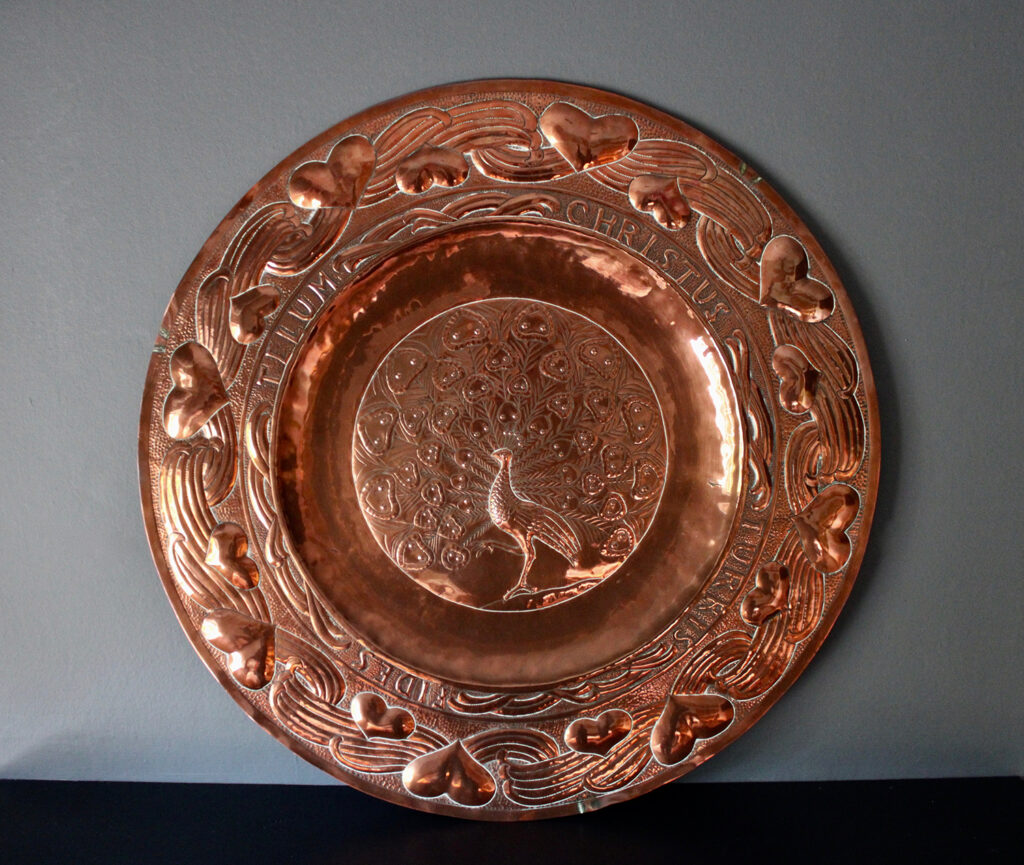
Fig. 27 – Circular copper dish designed by George Tanner, c.1900 (see p. 68). This popular design appears in several photographs (see Fig. 11) and was reproduced in The House, July 1900 (see Fig. 26).
This particular piece was embellished with the motto of the Fordham family, of Odsey village, Cambs., who probably commissioned it. (Private Collection).
In the winter of 1890 a class was begun by a local estate owner in the small village of Newton, Cambridgeshire. Like many philanthropic employers at the time the primary initiator was keen to improve the education and quality of life of workers in his community. The class would become the Newton School of Metal Work and continued to operate successfully for over half a century. The School began at the peak of the Arts & Crafts Movement as one of numerous classes under the umbrella of the Home Arts and Industries Association but it was one of a much smaller number to become both
thriving metal working school and a successful village industry. This article will explore the history of the School from beginning to end; the founders, key designers and workers and the organisations that influenced and shaped its success. Piecing together the history of a School that was little documented during its lifetime is never straightforward but it has been made much –easier by the foresight of a relative of the former tutor at the School who, thankfully, retained an important archive of designs and photographs. Over the last year this new Information has been studied and interpreted along with historical documents in order to teil the full story and deservedly raise the profile of this important but largely forgotten Newton School of Metal Work.
NEWTON VILLAGE
Newton is a small village situated around seven miles South West of the City of Cambridge. The origins of the village may predate the Saxon period. lt was linked with the neighbouring village of Hauxton until the sixteenth century when it became an independent civil parish. Later the village became a stopping point on the old coaching road between London and Cambridge. Predominantly surrounded by farmland, it has remained largely unchanged over the last century, consisting of a handful of streets that meet at an intersection. Agricultural work has always provided the main employment in the village. In the eighteenth and nineteenth centuries around 200 people lived here, while the current population is around 400. [1] When our story begins in 1890, Newton was a quintessentially English rural community where most inhabitants worked on the local estates and knew each other well.
At first Newton seems an unlikely location for the formation of an art metal-work school that would thrive for over 50 years. In the late nineteenth century, however, there were many philanthropic estate owners up and down the country who were keen to improve the ‘wes of their workers through education. The Arts & Crafts Movement was at its peak and national organisations like the Home Arts and Industries Association (H.A.I.A.) helped to establish amateur classes, reviving a wide range of handicrafts. All these factors came together in Newton to create the Newton School of Metal Work.
Among a small number of wealthy, influential families, most notable were the Hurrells, who had lived and farmed in the area since the seventeenth century. In the early 1900s the Waldsteins also assumed importance and Sir Charles Waldstein (1856-1927) — known as Sir Charles Walston after 1918 — built his country house, Newton Hall, around 1909. [2]
THE FOUNDERS
By the late nineteenth century the Hurrells were the principal landowners and employers in the area. William Hurrell (1813-1902), a successful farmer and landowner, lived at the Manor House with his wife and two sons, William and Harold. The Hurrell family had a long history of involvement in the local community and William himself was a Justice of the Peace and churchwarden. Around 1876, he established an evening class for the men and boys of the village that was held in a coach house during the winter. The subjects taught were reading, writing, arithmetic and a little singing that was accompanied on the concertina by one of the local men. [3]

Harold, William’s younger son, (Fig. 1) had a privileged upbringing, being educated at Eton and then Trinity Hall, Cambridge where he graduated with a Bachelor of Arts degree in June 1889. [4] Shortly after graduating from university Harold decided to take charge of the evening class his father had begun and redirect it. He attended an Arts and Crafts school in London to learn crafts that he could teach to the class in Newton. [5] Unfortunately no records exist to tell us which school he attended but the friendship he established around this time with the metal worker and designer, John Williams, offers a possible clue. John had joined Charles Robert Ashbee at the Guild of Handicraft in 1888. The architect, designer and social idealist offered Williams the chance to become a founder member of the Guild of Handicraft, a cooperative of craftsmen being set up in Whitechapel, London. By 1890 the Guild and School of Handicraft had workshops at Essex House in the East End of London. This was both a school and an independent Guild workshop where members taught students. [6] Williams was a lifelong friend and collaborator with Hurrell and so it is tempting to think that this was the school he attended.
Harold William Hurrell (1864-1926), was undoubtedly the catalyst that sparked the move towards producing handicrafts at the evening class. He was an enthusiastic teacher of many crafts including picture framing with brown paper, mosaic tile work, basket making, clay modelling and Venetian ironwork. [7] He was also the instigator of the move towards art metal work in 1890 and provided the required resources. The Old Vicarage coach house on Town Street, owned by the Hurrell family, provided an ideal central location for the School’s workshop from the beginning until the very end of its existence.
Hurrell supported the School for the whole of his life. He personally supervised the work of the class, undertook all the correspondence, arranged and attended the many exhibitions and oversaw the finances. He forged links with well-known designers from the Arts & Crafts Movement and, in the early years, aligned the classes with the H.A.I.A. He was tireless in his efforts up to his sudden death in 1926 and, although the School continued long after his death, it owed a huge debt to the enthusiasm of its founder.
Hurrell was a bachelor who lived throughout his life in the village, where he was best known for his work with the Metal Work School. In addition to taking a keen interest in village matters he took a prominent role in more public affairs. Having become a Justice of the Peace in 1903, he served as a Conservative member of the Cambridge County Council from 1904 onwards. His primary interest was education and he eventually became the Chairman of the Education Committee and a strong advocate for the proposed School of Arts and Crafts in Cambridge. [8]
There is still some uncertainty about the second founder of the Newton School. Thanks to a brief account of the School written around 1935, we know that a Miss Nash of Newton learnt brass and copper repoussé work in London and later passed on her knowledge as a teacher at the School. [9] Between 1891-1898 a Miss Nash is mentioned in several newspaper articles reporting on exhibitions of work by the Newton School. [10] lt appears that from the beginning the evening class was being run jointly by both Hurrell and Miss Nash. lt also appears that both taught metal working skills following their training in London. Around this time there were only two women called Nash living in Newton village, Ann Eliza Nash and Eliza Hester Nash, Eliza being Ann’s daughter. They appear to have been relatively wealthy, the 1891 census describing them as living on their own means along with a cook and housemaid. [11]
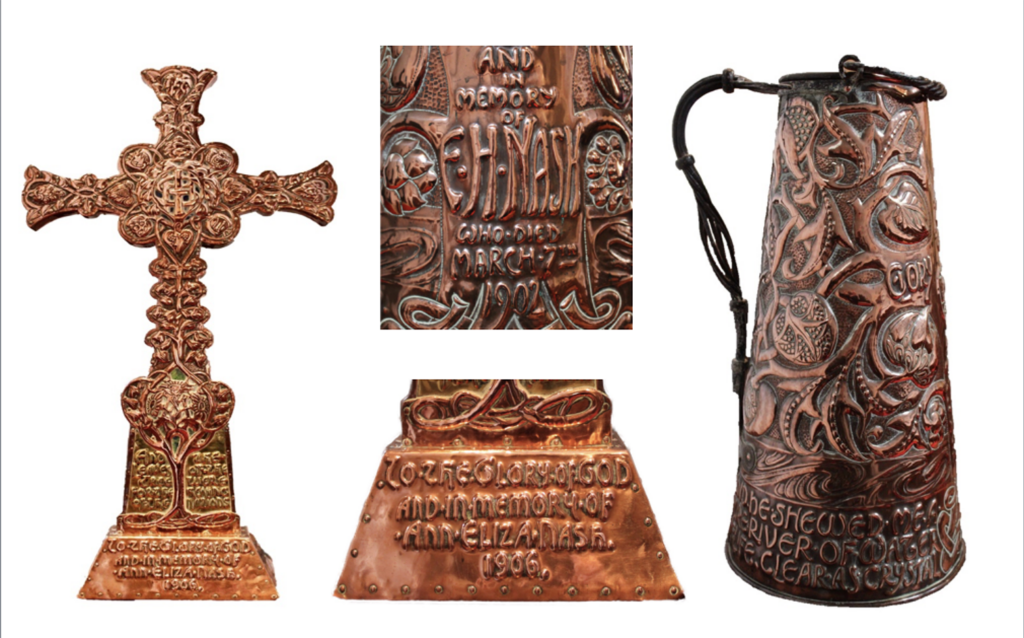
Two very impressive pieces of metal work by the School demonstrate the importance of both ladies to the village. (Fig. 2) An altar cross with fine enamel work is dedicated to Ann and a large font ewer is dedicated to Eliza. Both are superbly designed and of the highest quality and workmanship. lt seems most likely that Eliza taught at the School. lt was fashionable at this time for wealthy women to work on philanthropic ventures and it was actively encouraged by organisations such as the H.A.I.A. Eliza Nash died relatively young in 1902 [12], which may explain why she suddenly disappears from newspaper reports in the late 1890s. Ann Nash died a little later in 1906. [13] The full contribution of the Nash ladies may never be known but they clearly played a role and were fondly remembered by the workers from the School.

THE METAL WORKERS
lt is remarkable just how many of the Newton School workers are known, thanks to newspaper articles and attendance registers. Over 70 workers have been identified as being involved during its 50-year history, which represents a significant number of the families in the village. The workers were all men and boys; the youngest was only 11 years of age. (Fig. 3) Various newspaper articles frequently described the workers as horsemen and ploughmen, which the census confirms is broadly correct. The vast majority were agricultural workers living in the village and working on the local Hurrell or Walston Estates. Over the years the class size varied but typically 10-20 workers each year gave up their winter evenings. The School was profitable and profits after costs were shared fairly with the workers, providing a valuable second income for many families. [14]
Albert Aaron Prime (1875-1960), or Primey’, as he was affectionately known, was a memorable figure in Newton. He was short in stature of approximately five feet tall but played a major part in the history of the School. He was born in 1875 [15] and lived all of his life in the village. Prime left school at 12 and began working as a domestic helper for the Hurrell family. [16] He probably joined the very first evening classes run at the School during the winter of 1890 and was a fast learner, quickly becoming a rising star. Prime is first mentioned in relation to the School in 1896 when he began to win prizes for his metal work at local exhibitions. [17] In 1901 he was working on a farm as a teamster but sometime between 1901 and 1911 he became the first, and only, full time worker at the School. [18] Prime taught the evening classes but also worked at the School during the day, occasionally supported by others. The School was interrupted by the outbreak of World War One and Albert was directed to work at an instrument company in Cambridge, making range finders for the army until the war ended. After the death of Harold Hurrell he became the mainstay and driving force behind the School, which became Prime’s life for over 50 years (Fig.4).He continued to work and teach there until it was closed down during World War Two. Even after the School closed, Prime continued to use the workshop to design and produce commissioned pieces, working progressively less as he got older. He was highly skilled in all aspects of metal working and produced items in iron, copper, brass, pewter and silver.
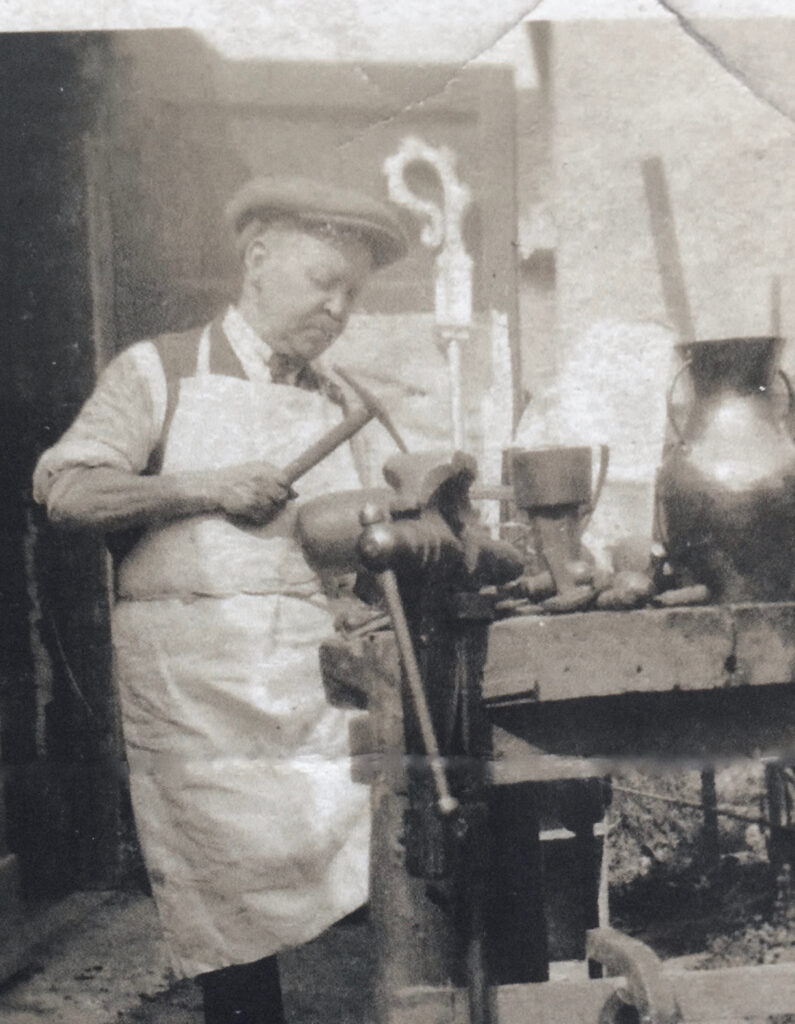
John Williams (1867-1951), was one of six children. His father was a warehouse manager and the family lived in St Luke’s in London. He gave up school at a young age and was initially employed as a clerk for a Manchester agent. [19] From these humble beginnings he became a renowned metal worker, designer and teacher in the Arts & Crafts Movement. Williams must have shown early talent since, in 1888, he began working with a handful of skilled craftsmen at the Guild of Handicraft. His involvement was successful but relatively short lived as by 1892 he had moved on to other opportunities. [20] For the next few years, he taught handicrafts for the Surrey County Council. He also dedicated a significant amount of time and effort to two schools associated with the H.A.I.A.; the Newton School and the Fivemiletown Class. His association with the Newton School began between 1890 and 1892. He was a gifted designer with a distinctive style and it seems likely that he would have visited Newton to support and teach.
Around the same time Williams also became involved with the Fivemiletown Class in County Tyrone in Ireland, initiated in 1892 by Mary Montgomery, the wife of a local landowner. [21] The dass exhibited at the H.A.I.A. exhibition in 1893 and it is likely that Williams became aware of their work through that exhibition, since he was sufficiently interested to travel over to Ireland the following year to provide some teaching. He revisited the class in Ireland in 1894 and again in 1896 by which time he had become head of the art department at the Northampton Institute (now the City University) in Clerkenwell. [22] The body of work produced by both schools can look similar, as Williams employed similar styles of foliage, animals and birds in his designs, with peacocks being a particular favourite. (Fig. 5)
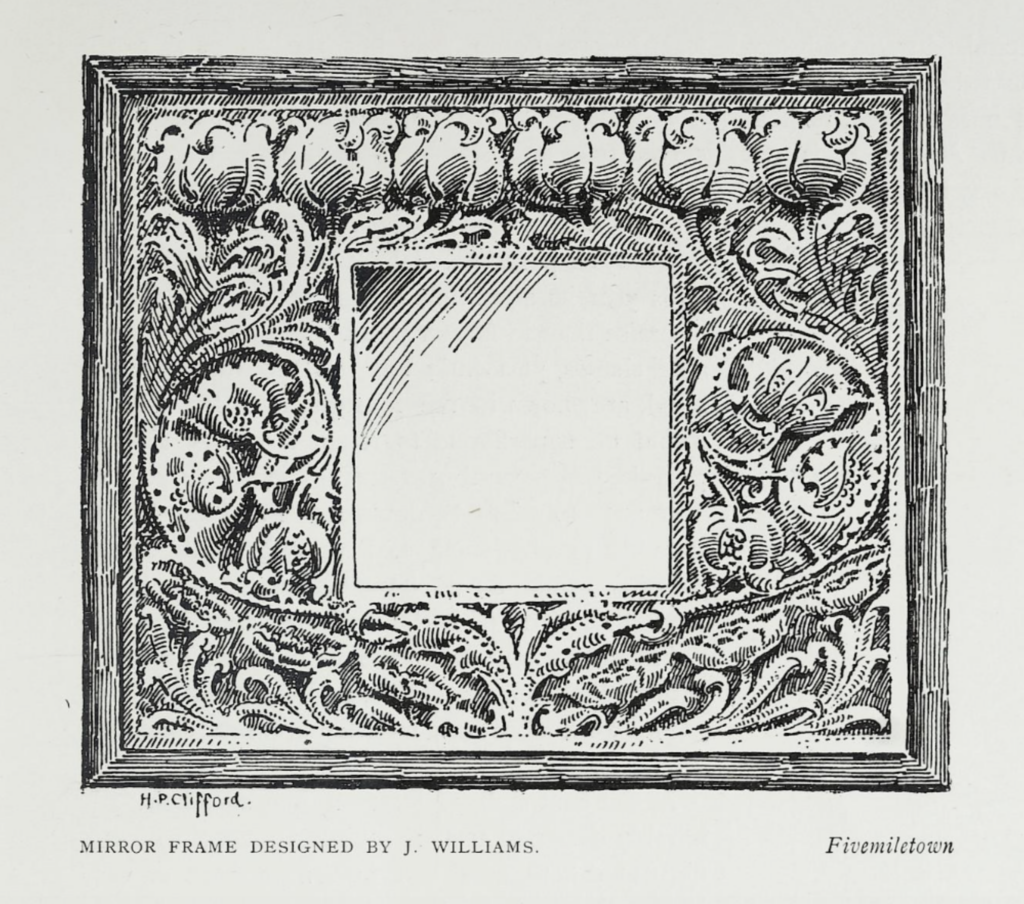
Both classes were very successful; Williams provided significant support through the 1890s although his direct involvement lessened early in the 1900s. Later he was also involved in the Cambridge Arts & Crafts Society and on at least one occasion judged metal work at their exhibitions. [23] He remained friends with Harold Hurrell throughout his life as evidenced by a silver dish he designed and made, hallmarked for 1927, in memory of his death. (Fig. 6)
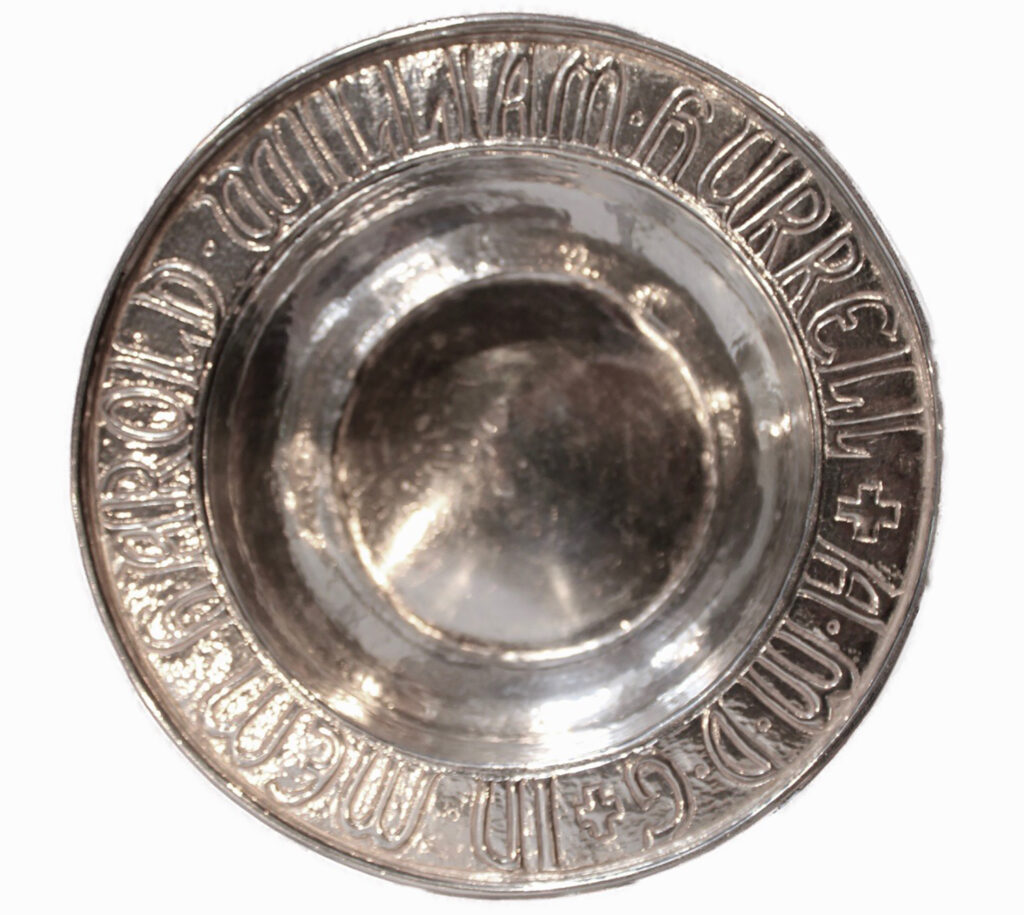
Mary Williams (1869-1951) was two years younger than her brother John, and evidently followed in his footsteps as a designer and maker of art metal work. Between 1901 and 1911 she worked full time as an art metal worker in London. [24] Very little is known about Mary who, like so many female craftspeople of her time, was overlooked in favour of her male counterparts. We know that Mary Williams was also involved with the Fivemiletown Class providing them with both designs and tuition. Like John, she also visited Ireland in the 1890s [25] and exhibited some of her own metal work there in 1896. [26] Mary’s only documented design appeared in The Studio in 1899. [27] (Fig. 7) The style is noticeably similar to her brother’s with broad leaf foliate patterns on a tapering, twin-handled vase.

A fender exhibited at the 1897 Home Arts & Industries Exhibition and illustrated in The Studio, was designed by “M. & J. Williams” suggesting that brother and sister collaborated on designs for the Newton School. [28] (Fig. 8) Albert Prime spoke of Mary as an able designer. Fortunately a copper repoussé mirror made by the School, dated 1907, is marked as a design by M. Williams, suggesting that her involvement at the School lasted for a least a decade. Unless further information comes to light, we will never know the full extent of Mary’s contribution but she probably provided tuition and designs for the School during the 1890s and early 1900s, alongside her brother.
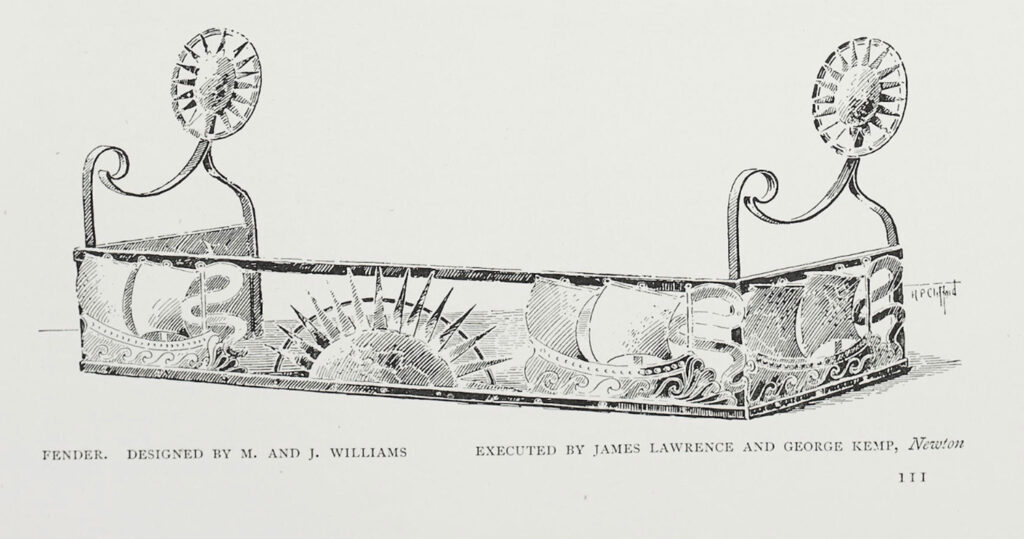
George Tanner (1869-1956), was born in South Lambeth, Surrey, the only child of Stephen and Mary Tanner. By 1881 the family were living in Godalming, where George was to spend most of his life and where his father ran a successful Drapers and Outfitters. [29] Stephen Tanner became Mayor of Godalming in 1885. [30] On leaving school George joined the family business; his occupation was listed as ‘draper’ in the Census, in both 1891 and 1911. He clearly had other ambitions however, since in 1901, George was listed as ‘designer’ suggesting there was a period where he was able to explore his creative talents. [31]
George Tanner (1869-1956), was born in South Lambeth, Surrey, the only child of Stephen and Mary Tanner. By 1881 the family were living in Godalming, where George was to spend most of his life and where his father ran a successful Drapers and Outfitters. [29] Stephen Tanner became Mayor of Godalming in 1885. [30] On leaving school George joined the family business; his occupation was listed as `draper’ in the Census, in both 1891 and 1911. He clearly had other ambitions however, since in 1901, George was listed as ‘designer’ suggesting there was a period where he was able to explore his creative talents. [31]
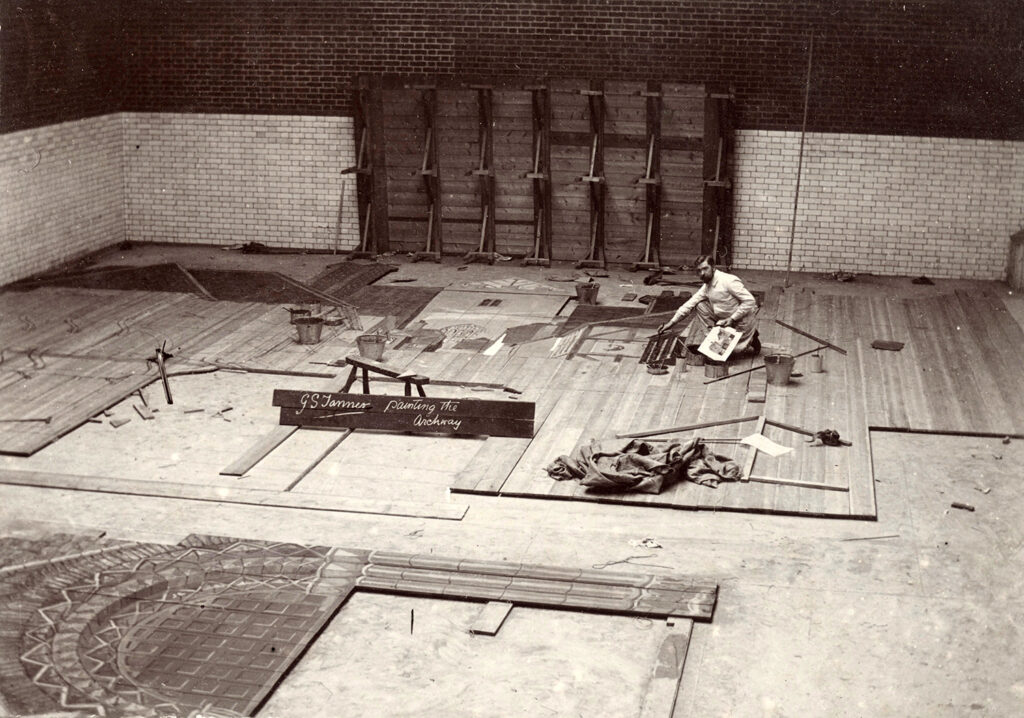
Tanner was a skilled artist, specialising in painting theatre backdrops and scenery. He is best remembered in Godalming for producing substantial painted archways for civic celebrations including Queen Victoria’s Golden Jubilee in 1897 and the coronation of King Edward VII in 1902. (Fig. 9) He was also a playwright and amateur actor, writing over 20 plays and starring in many of them. [32] Tanner clearly had an interest in the decorative arts and in the late 1890s he entered a number of competitions in The Studio under the pseudonym ‘Sixpence’, (a `tanner’ being a nickname for a sixpence at the time). [33] In 1896 Tanner won first prize for his design of a repoussé dish and second prize for a design for fretwork. Several of his designs were illustrated. [34] (Fig. 10)
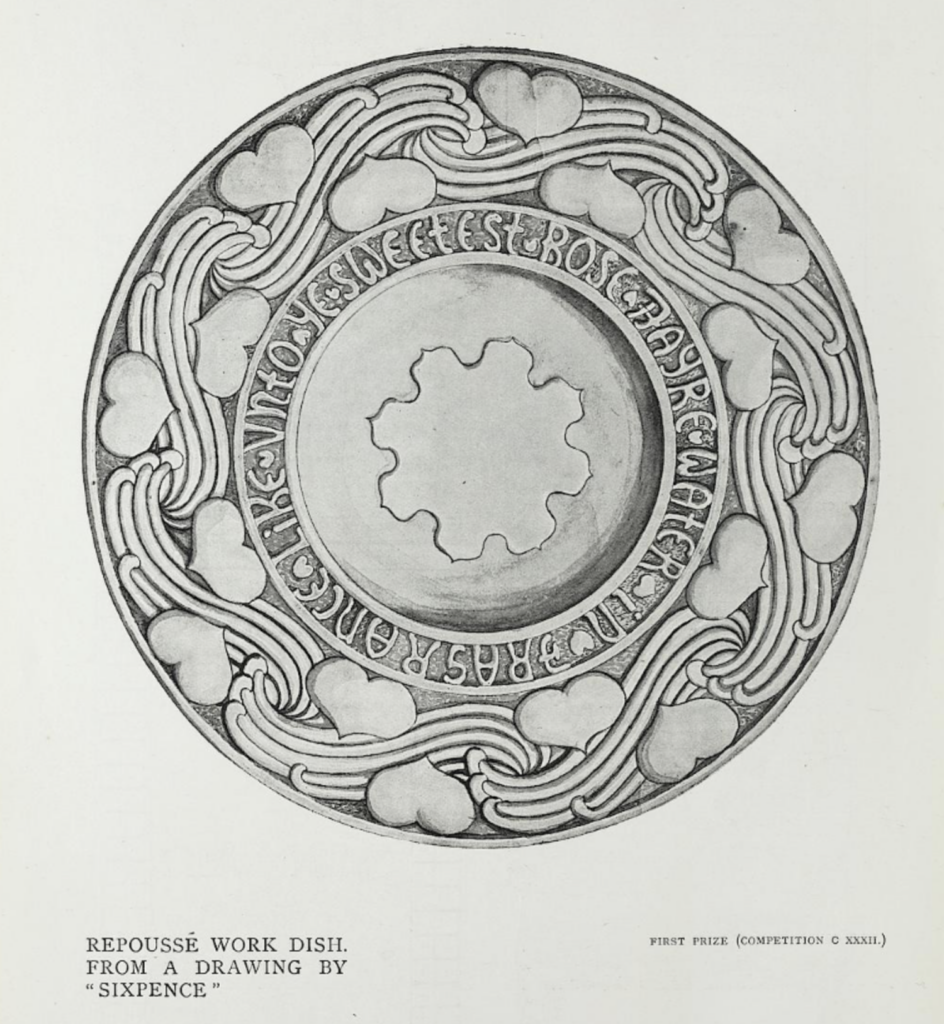
Quite how a designer from Godalming became involved with the Newton School is unclear. It is probable that Hurrell met Tanner through the H.A.I.A. and encouraged him to design for the School. Fortunately, Tanner signed and dated his designs, enabling us to date his involvement to between 1897 and 1907. The design for the repoussé dish illustrated in The Studio in 1896 could signal the start of his connection as variants of this design are known to have been made. (Fig. 11) Over a 10-year period Tanner produced over 150 designs for the School, each beautifully drawn and carefully annotated. As John Williams’s involvement declined at the start of the twentieth century these designs would have become increasingly important.
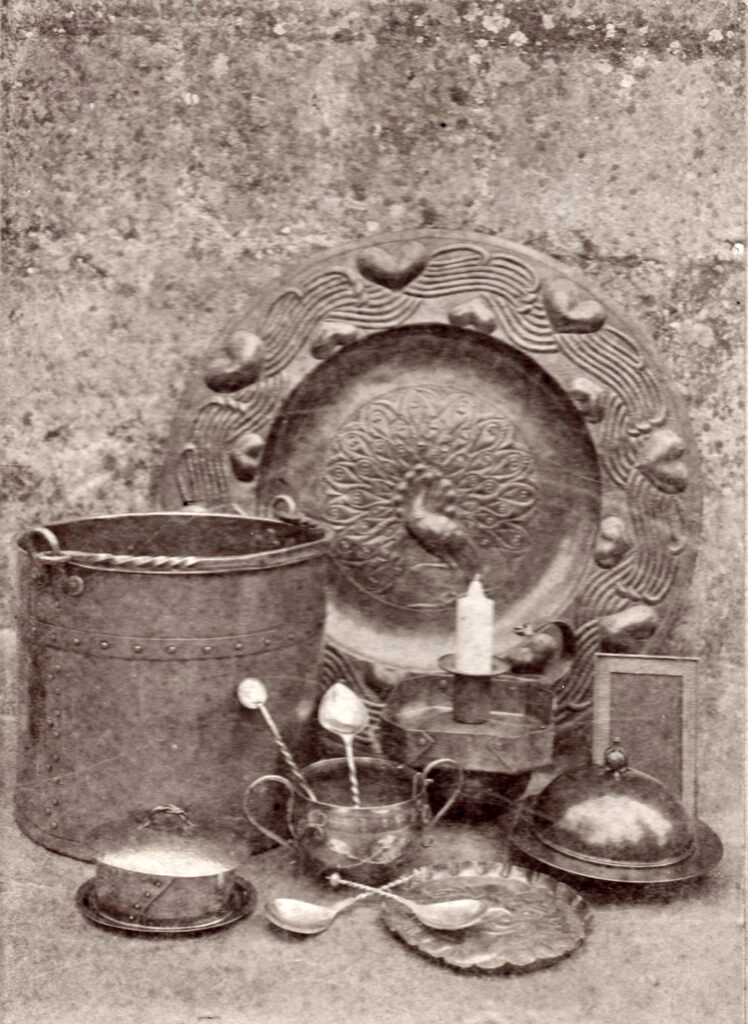
THE HOME ARTS & INDUSTRIES ASSOCIATION
The H.A.I.A. was founded in 1884 by the social reformer, Eglantyne Jebb. Its main mission was to revive traditional crafts to assist in overcoming poverty in rural areas. The organisation embraced one of the central tenets of the Arts & Crafts Movement, taking from the teachings of John Ruskin and William Morris a belief that traditional handicrafts sustain rural communities, while those employed enjoyed far greater personal satisfaction than a typical urban factory worker in their job.
In 1888 the organisation moved its offices to the Royal Albert Hall in South Kensington where it also held its annual exhibitions until 1913. lt successfully established classes all over the country. In 1889 it had 450 classes, 1000 teachers and 5000 students. [35] Several of the classes became well known for metal work, including the Yattendon Metalworking Class, the Newlyn Industrial Class, the Keswick School of Industrial Art, the Fivemiletown Class and the Newton School of Metal Work.
lt is uncertain when the School became associated with the H.A.I.A. The Studio published an article on their exhibition in 1895, the first time we hear of the School exhibiting with the Association. The article states that, ‘Some repoussé work, in which the admirable influence of Essex House was apparent, came from Newton, near Cambridge’. [36] The reference to Essex House makes another link to the Guild of Handicraft and John Williams. lt is likely that the School exhibited annually with the Association, which provided a valuable showcase for their work, from at least 1895 through to 1913. A photograph of the exhibition stand at the H.A.I.A. exhibition in 1913 shows the Newton School at the last of the Association’s exhibitions. (Fig. 12)
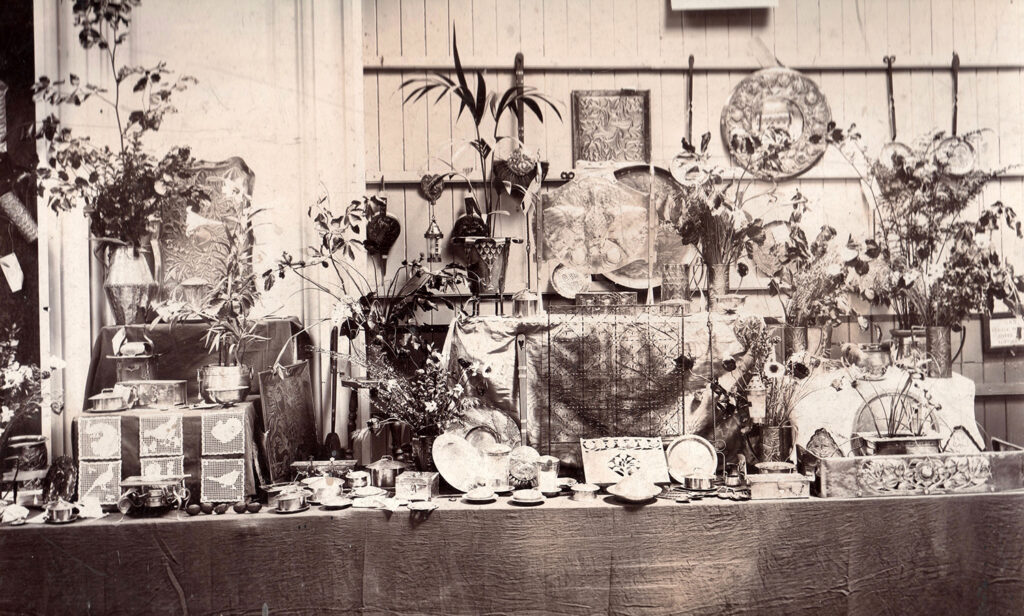
THE GUILD OF HANDICRAFT
The influence of the Guild of Handicraft on the Newton School is hard to determine since John Williams, the most obvious link, left the Guild after an apparent falling out in 1892. [37] The archive of designs from the School provides a clue as one of the earliest designs produced specifically for Harold Hurrell, and signed by John Williams, is also marked, ‘Guild of Handicraft, Essex House, Mile End’. This dates the design to between 1890 and 1892 and suggests that Hurrell met Williams before he left the Guild. (Fig. 13)
The only other dated designs by Williams begin in 1892. Similarly a handful of designs in the archive by John Pearson, one of the best known metal workers at the Guild of Handicraft, are all dated 1892 or 1893. John Pearson and John ‘Williams were the first two metal workers at the Guild in 1888 and both left in 1892. (38) Clearly both worked with the Newton School immediately after leaving the Guild. John Williams stayed for many years; his time at the Guild influencing the designs and techniques he employed. John Pearson’s involvement seems to have been limited to providing a small number of designs over two years. (Fig. 14)
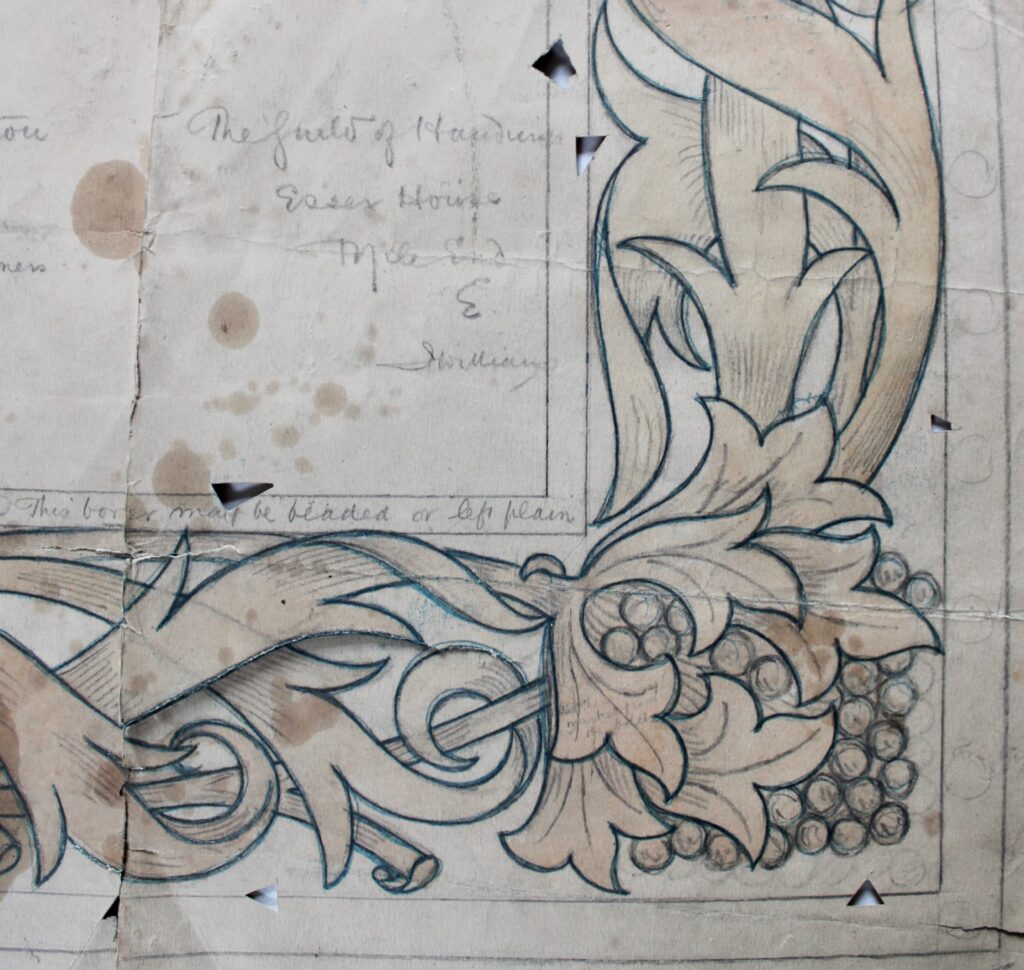
The only other dated designs by Williams begin in 1892. Similarly a handful of designs in the archive by John Pearson, one of the best known metal workers at the Guild of Handicraft, are all dated 1892 or 1893. John Pearson and John Williams were the first two metal workers at the Guild in 1888 and both left in 1892. (38) Clearly both worked with the Newton School immediately after leaving the Guild. John Williams stayed for many years; his time at the Guild influencing the designs and techniques he employed. John Pearson’s involvement seems to have been limited to providing a small number of designs over two years. (Fig. 14)
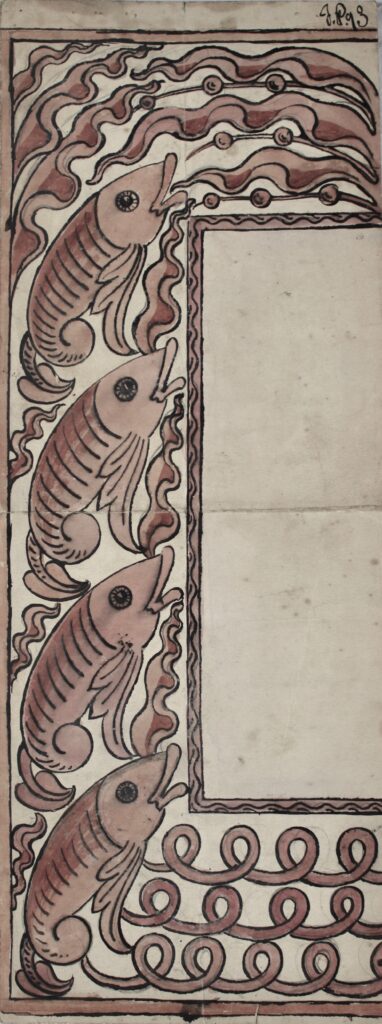
CAMBRIDGE COUNTY COUNCIL
In 1895 Cambridge County Council formed the Technical Instruction Committee and appointed Austin Keen as secretary. An enthusiastic educationalist he joined just as a scheme to promote rural education had begun. [39] That year the organisation held its first exhibition at the Cambridge Guildhall, showcasing handicrafts produced in over 70 villages. [40] The Newton School exhibited at the event suggesting that by this time they were receiving grants from the Council to support the enterprise.
In 1903, Austin Keen, who was then Education Secretary for Cambridge County Council, wrote an official report on Evening Schools:
“The grandest work in this direction that I know of is done by Mr. Hurrell of Newton. Last year the Newton School turned out £219 worth of metalwork, producing a substantial profit for the workers. This occupies six months of the year. As soon as the spring is fairly in, the school is closed and the men are encouraged to work on the gardens and allotments. Nor is the school simply a manufacturing or producing one; the educational side of the work is by no means neglected. The young men are systematically taught drawing and designing especially as applied to their repoussé work, forging, soldering, metal plating and enamelling. lt is intensely interesting to see a group of agricultural workers collectively working out the details of an elaborate design in which probably each of the branches above-mentioned is illustrated and applied — all of them exercising an intelligent knowledge of the detailed drawings and a splendid enthusiasm in translating them into metal form. For such men life has an additional significance to anything the day school ever imparted.” [41]
In 1910 Harold Hurrell referred to the fact the School was supported by the County Council [42] and, given Harold’s links with the Council, it is likely that these grants continued for many years, possibly until the final classes in the 1940s.
THE DEVELOPMENT OF THE SCHOOL
The very first report of the School’s work appears in December of 1891 at an exhibition in Royston:
“Among articles not for competition, special mention should be made of the interesting collections of artistic handiwork sent in from the Newton Evening School under the direction of Mr. Hurrell and Miss Nash. From the Newton School 64 articles were exhibited. Principal exhibits were in Venetian ironwork, repoussé work in brass and copper many of the articles being pretty in design.” [43]
Small exhibitions were held in Newton and Cambridge in 1893. (Fig. 15) The School exhibited at Council exhibitions held annually in Cambridge, from 1895 onwards, and quickly began to win the majority of the prizes awarded.
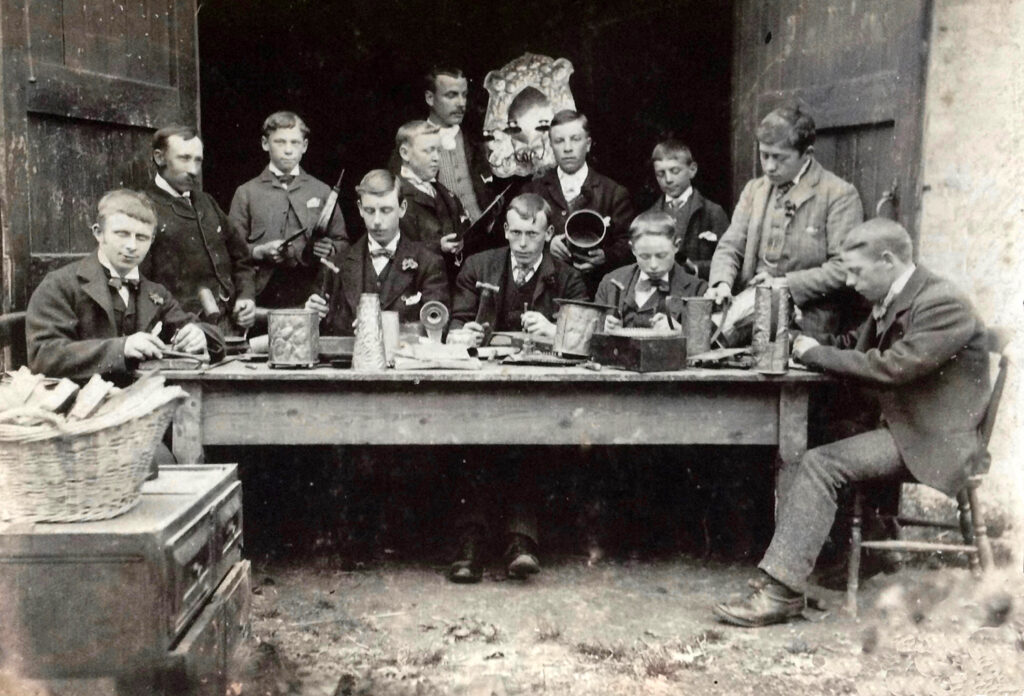
1895 was an important year for the School as it was the first time they were featured in The Studio’s coverage of the H.A.I.A exhibition. [44] lt was also the year the School gained royal patronage through a commission to make two large panels for the Prince of Wales. [45] (Fig. 16) In 1896 and 1897 the School featured in articles on the H.A.I.A. exhibition. In 1896 a cup design by John Williams was illustrated. The article praised both the School and John Williams:
“The Newton metal work included a fine panel of peacocks, part of a scheme for a complete decoration for a fireplace, which will be illustrated later on in The Studio when the work is finished. These proved to be designs by John Williams, whose admirable work at Essex House all visitors to the Arts and Crafts cannot fail to remember. In several classes this year, when a peculiarly good design for pierced or repoussé brass or copper caused one to examine the label the name of “John Williams” as its designer explained the situation at once”. [46]

(Private Collection)
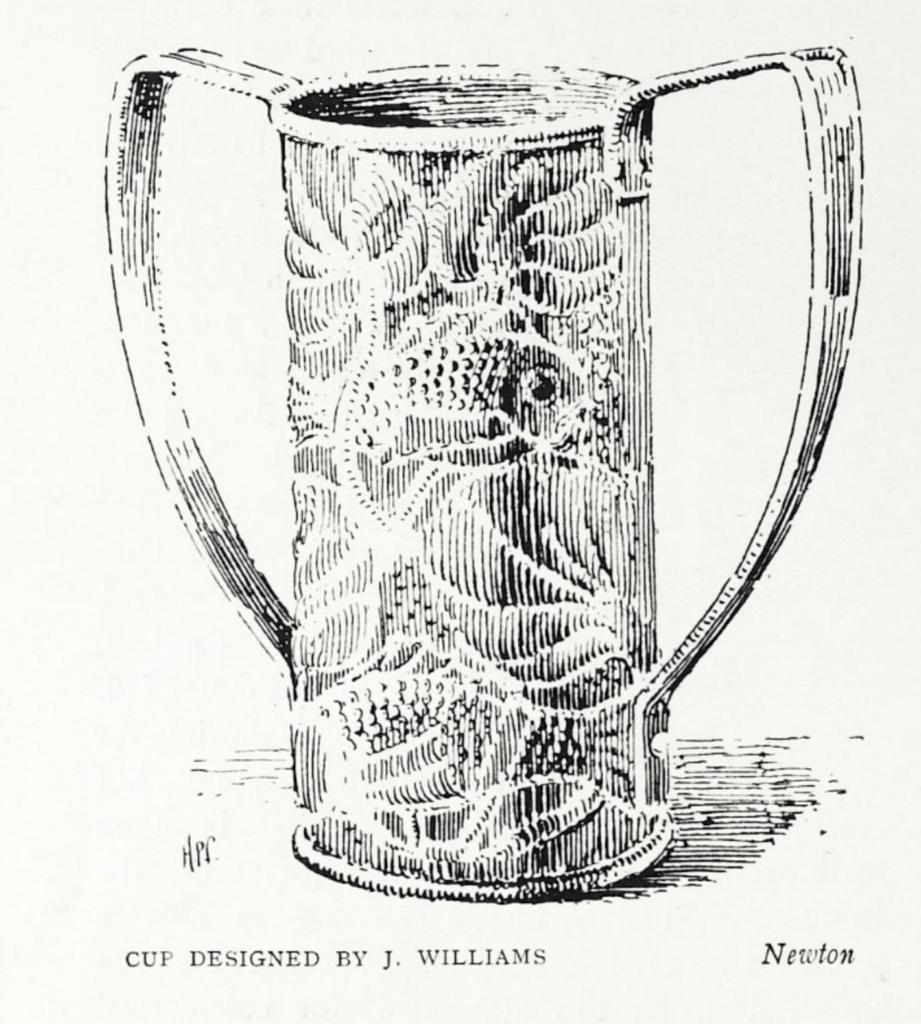
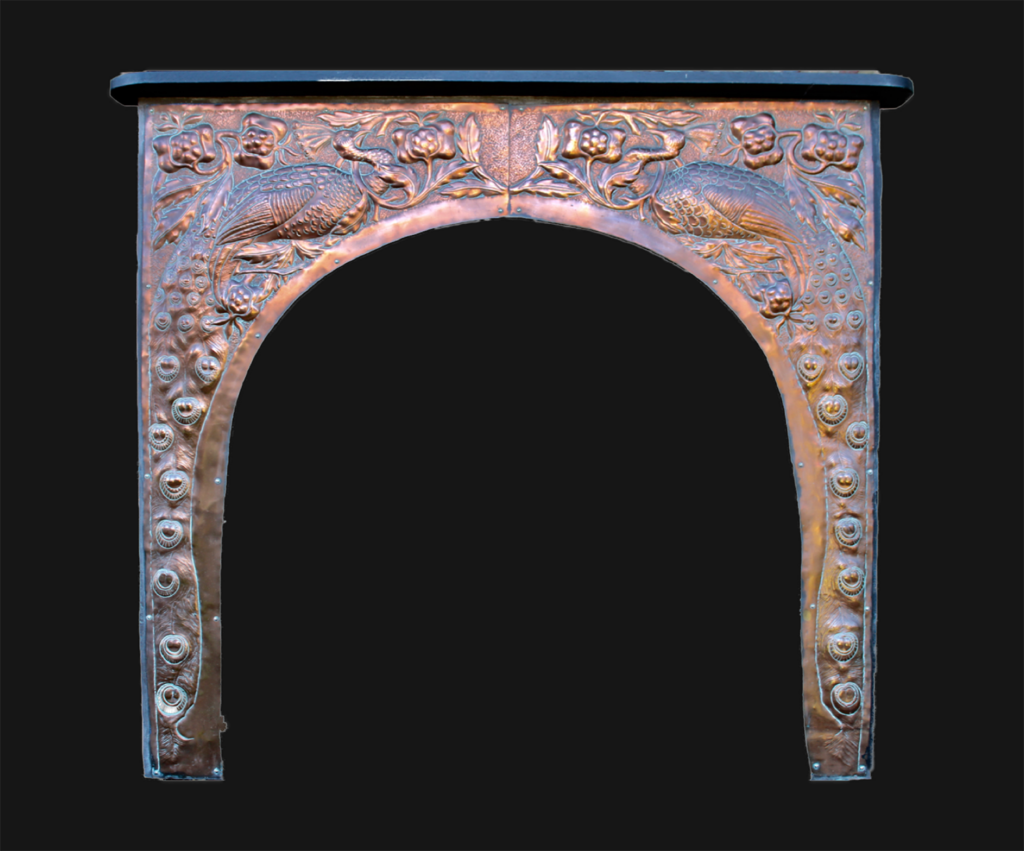
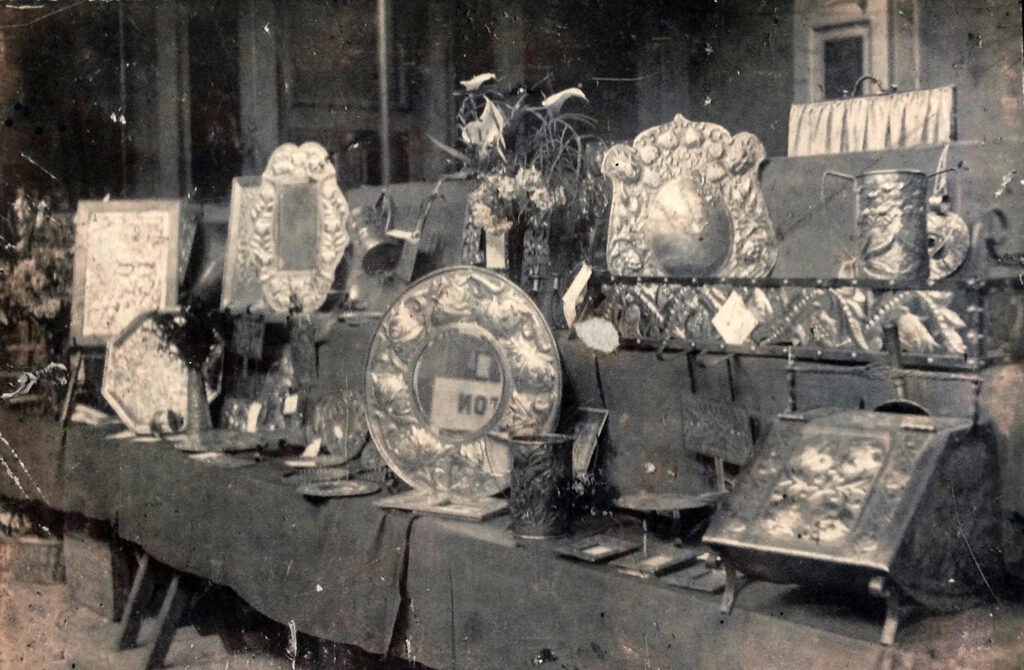
From 1890 to 1897 John Williams provided the majority of the designs used by the School to build their reputation. Like many designers at this time, he was heavily influenced by the natural world and his designs included flowers, foliage, birds, animals and fish. (Figs. 17, 18) Fruiting flowers, pomegranates and broad leaf foliage were motifs used extensively by other Arts & Crafts designers, notably in the wallpapers of William Morris; yet Williams’s design vocabulary remains distinctive. The patterns frequently employ conventionalised leaf motifs, often with repeating circles travelling the length of the stems. Only a small number of patterns in the archive are signed but more than 200 can be attributed to Williams or his sister, based on style and handwritten annotations. (Figs. 20, 21, 23) Williams designed an array of items for the School including mirrors, trays, picture frames, candle sconces, chambersticks, planters, vases, dishes, letter holders, fire screens, fenders, door plates, trivets, clocks and chargers. (Figs. 19, 22)
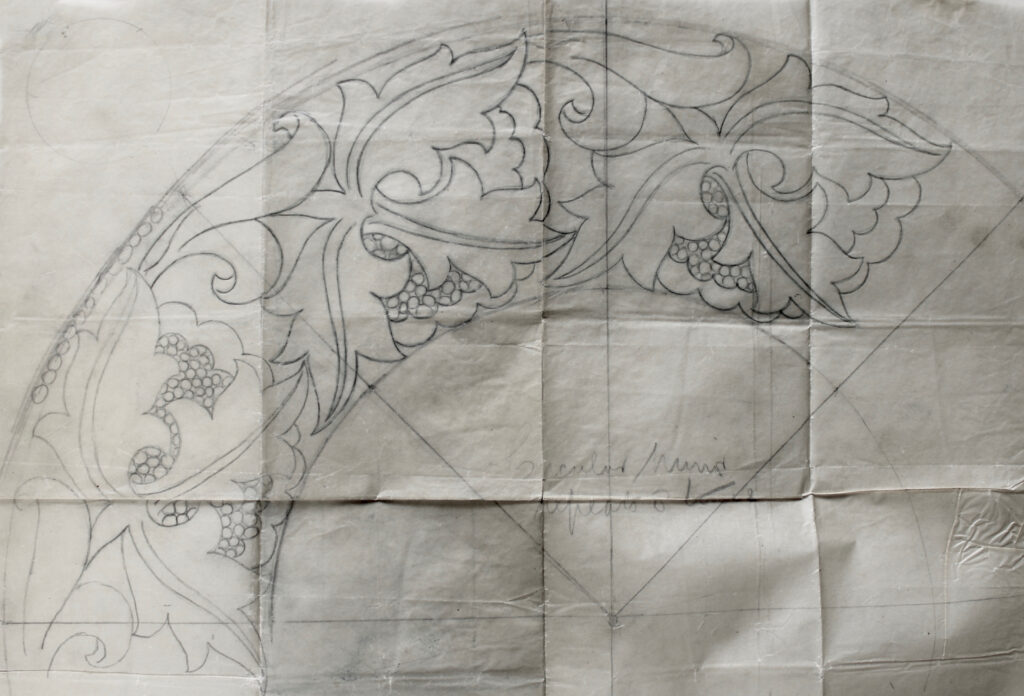
c.1900. (Private Collection only)
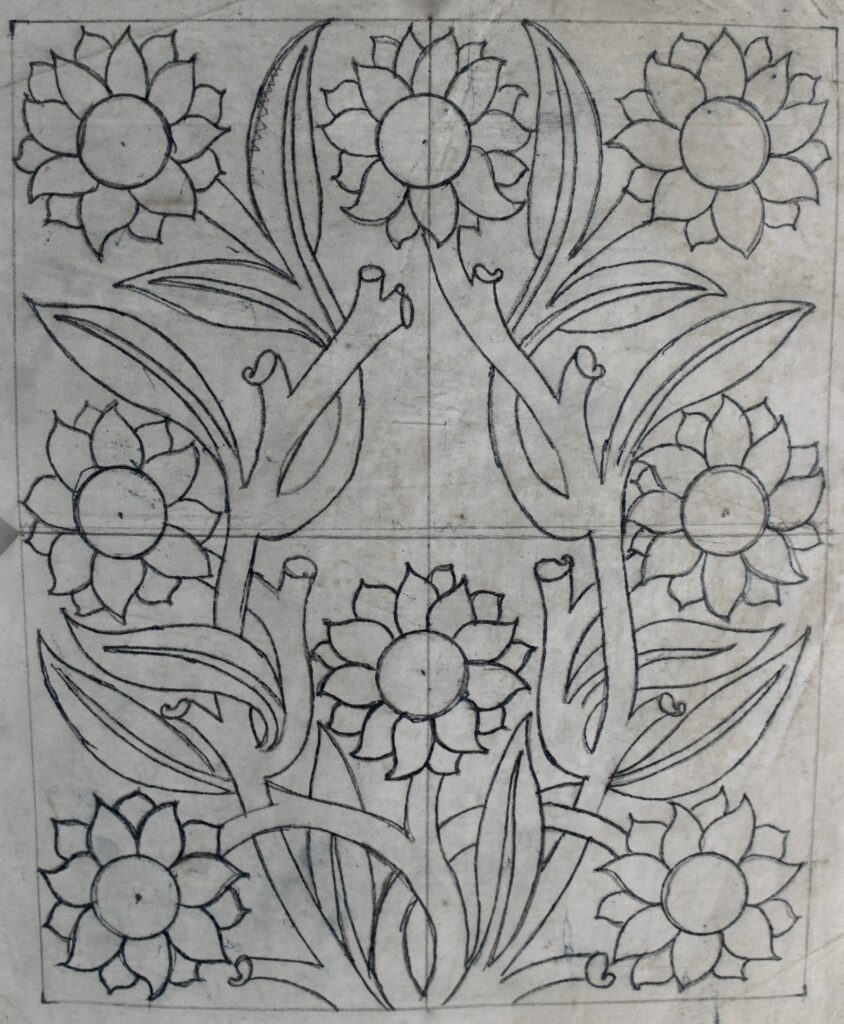
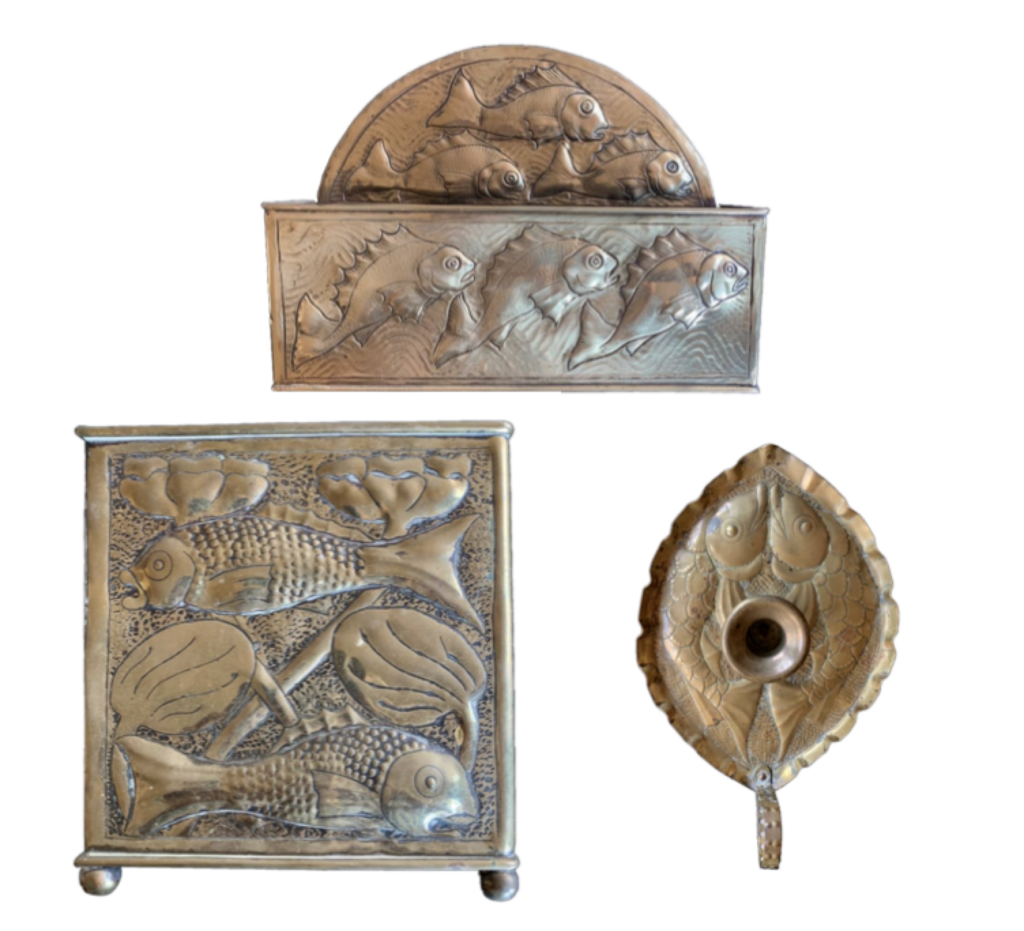
George Tanner began designing for the School in 1897 and his imaginative designs were diverse and markedly different from those of John Williams. Despite having no known association with other makers, his designs — often in watercolour and usually signed and dated — always included copious notes on how the item should be made. Many of his designs were made by the School, expanding their repertoire and showcasing the high level of skill the workers had acquired since the earliest years of the venture. The H.A.I.A exhibitions in 1898 and 1899 featured much of Tanner’s work. [47] (Figs. 24, 25) Interestingly, designs by Tanner and John Williams were illustrated side by side in an article of 1900, about the H.A.I.A. exhibition. [48] (Fig. 26, 27 – see p.54)
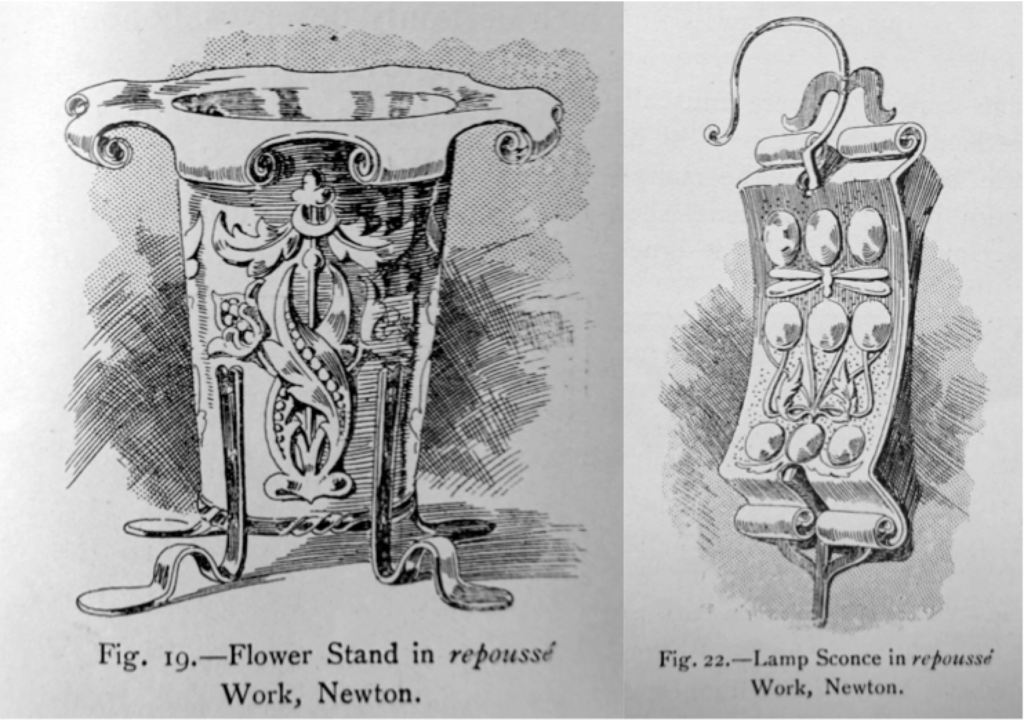
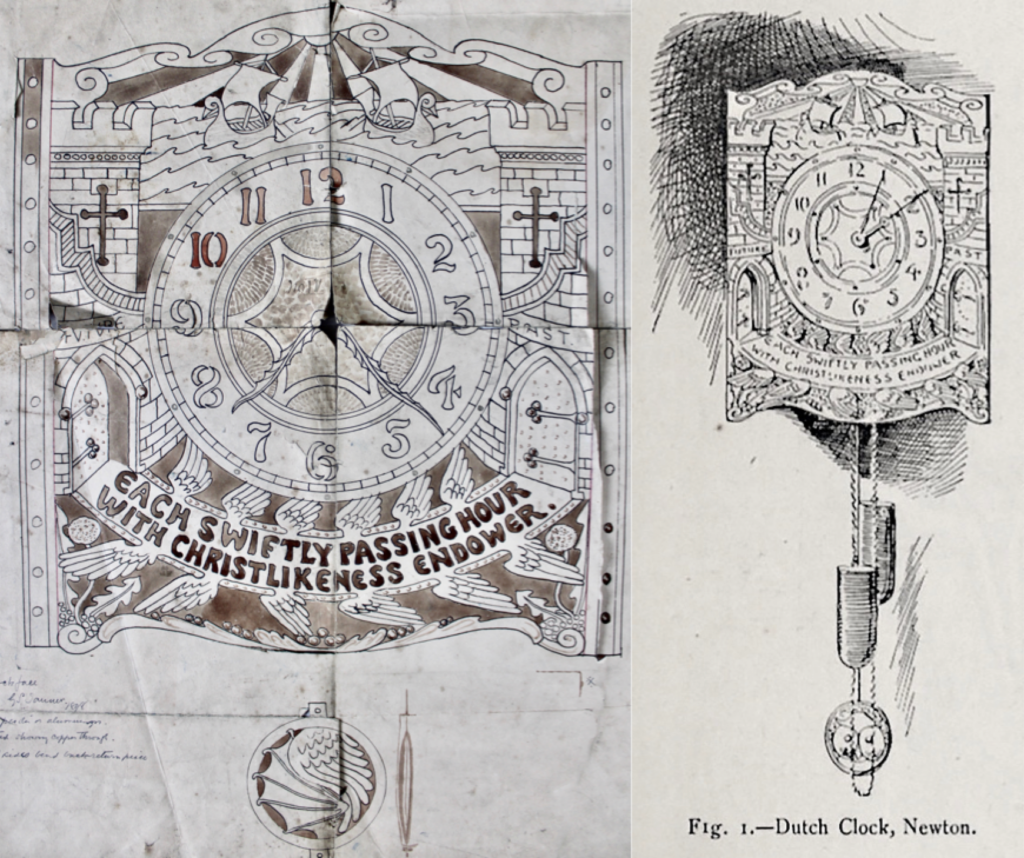
Similar ‘Dutch Clock’ exhibited at the H.A.l A., 1899, illustrated in The House, Vol. 5, No 29 ( July 1899); p. 162 (copy photo courtesy Tony Peart).
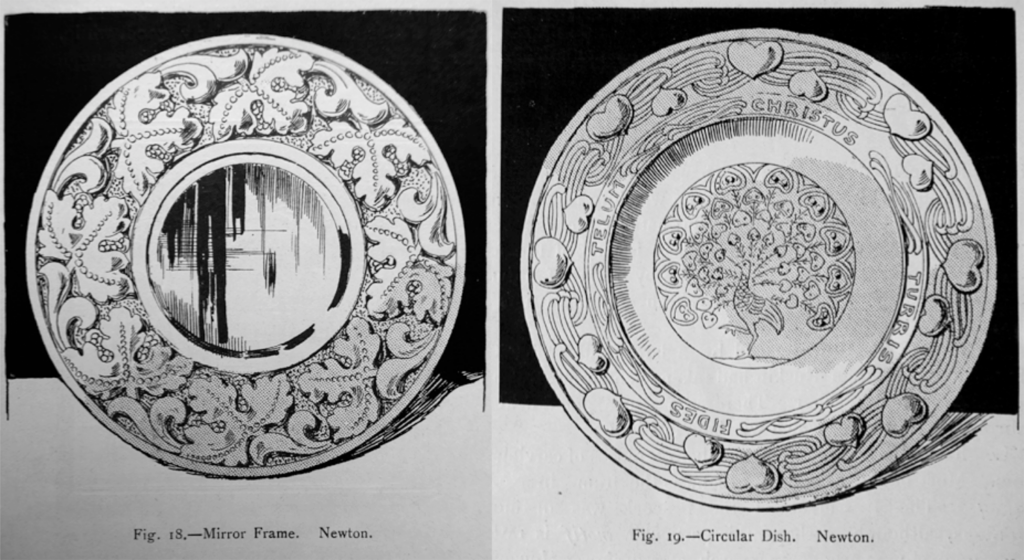
exhibited at the H.A.I.A., 1900, illustrated in The House, Vol. 7, No 41 (Jul 1900); p. 167.
(copy photo courtesy Tony Peart).
The School continued to exhibit annually at Council exhibitions in Cambridge. Viscount Peel made the following remarks in his opening speech in 1900:
“There was a village in this county, five or six miles from Cambridge, called Newton where there was a population of 150 people. [Viscount Peel] saw some clocks before him which he believed came from Newton. The inhabitants were a purely agricultural people, but they had been induced, chiefly through the energy of one individual, to take up the subjects of iron work and copper work, with the result that at the end of the year they had produced — not in substitution of their ordinary work, for that would be a mistake, but in addition, and supplementary to their ordinary work – £150 worth of goods, and when the balance was struck, and the expense of the material and other expenses deducted £100 was returned to the inhabitants of that village as the product of their supplementary labour.” [49]
The only other documented appearances by the School at the H.A.I.A. exhibitions were in 1901 and 1905. A milk jug and string box designed by George Tanner, were illustrated in The Artist in 1901. [50] (Figs. 28, 29, 30) In 1905 the School exhibited a design for a panel with a peacock motif by John Williams, showing the continuing use of his designs during this period. [51]
By 1905 the range of designs had increased substantially thanks to John Williams and George Tanner and the work produced by the School was more varied, often including roundels made by the Ruskin Pottery for decoration. The School appears to have had a steady supply of talented, new workers from the village and the consistent quality of their work suggests that Albert Prime was an able tutor. Fashions and tastes had no doubt changed since 1890 but the School, thanks to the tireless efforts of Harold Hurrell, regularly won high praise and found eager customers for the now thriving village industry.
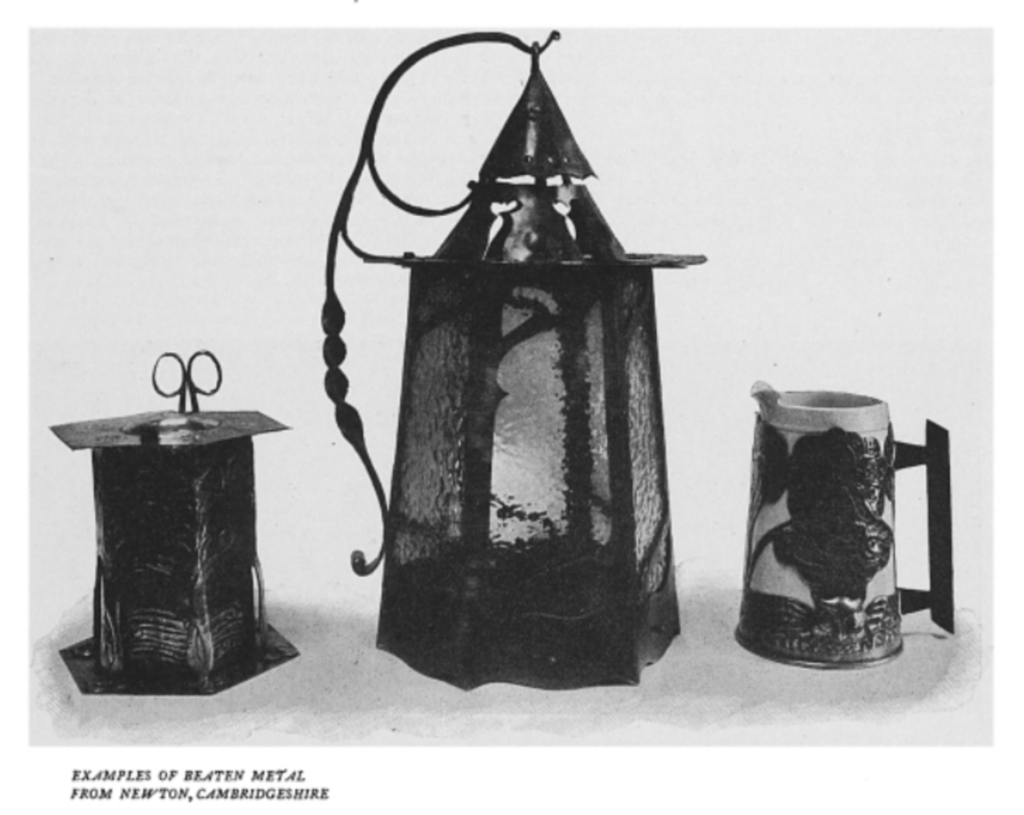

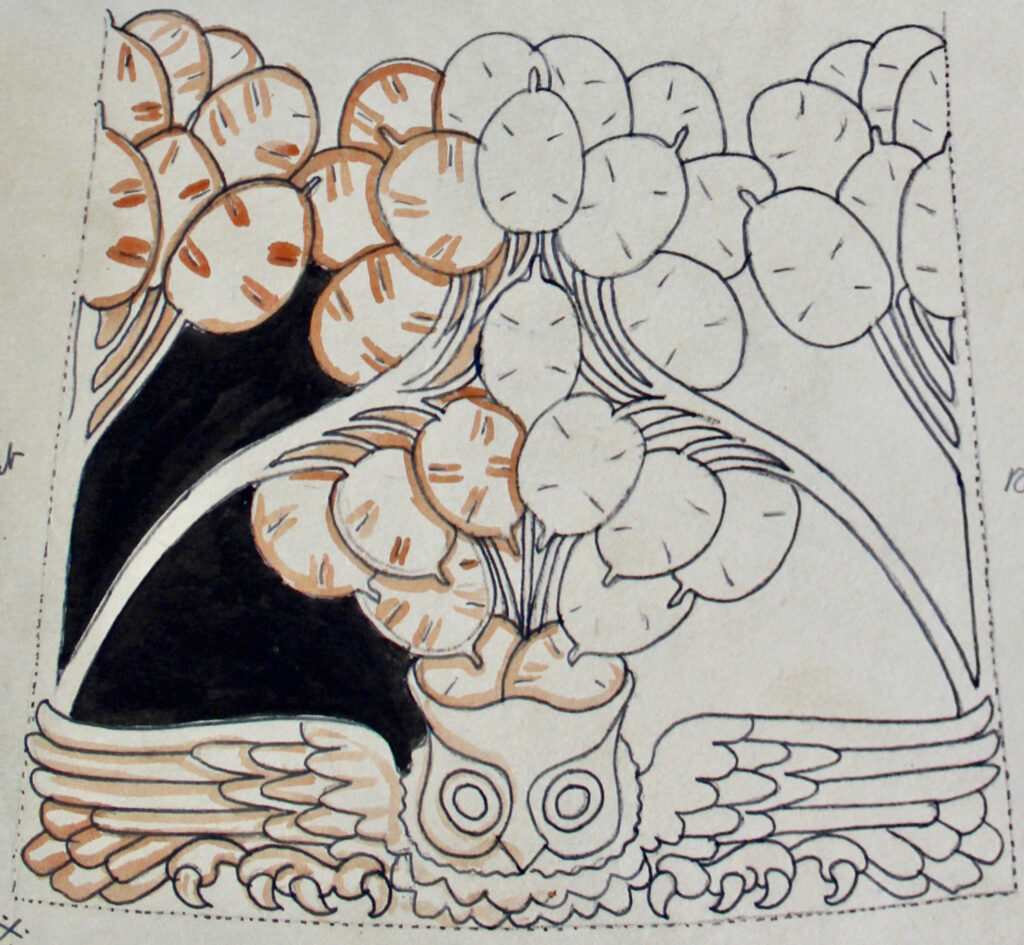
THE CAMBRIDGE ARTS AND CRAFTS SOCIETY
The formation of the Cambridge Arts and Crafts Society, in June 1906, coincided with the end of the Council exhibitions. The Society held its first exhibition in the same year at the Guildhall in Cambridge. [52] Over several years the Society’s five exhibitions gave the School an important platform to display their work alongside some of the best metal workers in the country. Charles Waldstein (later Walston), Slade Professor of Fine Art, became President of the Society in 1907 and Harold Hurrell is listed as the Honourable Treasurer. Even Austin Keen was elected a vice-president and other members included a Mrs Jebb (very likely Eglantyne Jebb, who lived in Cambridge at the time). [53] The annual exhibitions continued and in 1908 the School that was described as ‘that fine example of Village Industry which shows no signs
of decay’. [54] Interestingly, the metal work section was judged by a Mr. J. Williams of Hornsey, with Harold Hurrell acting as a steward, so it is clear that both men were actively involved in the Society. The fifth, and final, exhibition by the society was held in May, 1914 and the Newton School exhibited once again. [55]
The Society appears to have ceased operating in 1914, most likely hastened by the onset of World War One.
The work of the Newton School was also brought to an abrupt halt by the start of the War. Many of the workers enlisted in the armed forces and the School re-started only after the War ended. A significant number of villagers saw active service; 50 men joined up out of a population of less than 200. Although a number were killed, including some known workers from the School, the village was grateful for the many who returned home safely. [56] (Fig. 31)
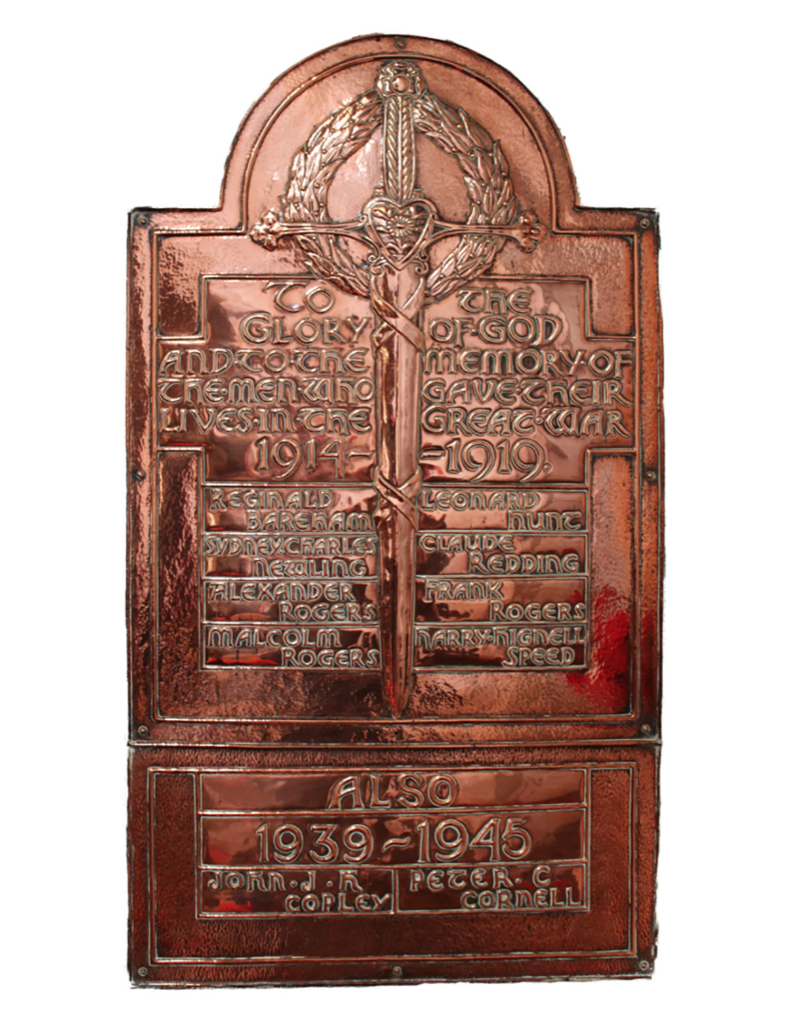
THE INTER-WAR YEARS
By 1920 Newton School was operating as before with Albert Prime returning to his role as tutor. There are fewer references to exhibitions during the 1920s due to changes in the organisations that had provided opportunities before the war. The H.A.I.A. exhibitions had ended and the Cambridge Arts and Crafts Society had also ceased operations. An image shows a group of metal workers from the School outside the workshop. Believed to date from around 1926, it was taken ahead of a forthcoming exhibition, thought to be the British Industries Fair. The metalwork on display in Fig. 32 remains very much in the Arts & Crafts tradition and many of the designs date back to the School’s early years. This is surprising as tastes had changed markedly with increasing emphasis on modernity and the Art Deco style. John Williams and George Tanner had ceased to be involved and any new designs would have come from the metal workers themselves.
Harold’s death in 1926 would have been a serious blow. He had worked tirelessly for many years to promote the School, building up a network of influential contacts in the Cambridge community and further afield. By this time, however, Albert Prime was well established as manager and the school had a strong reputation. It could count on support from both the County Council and the Hurrell family, who continued to allow their workshop to be used.
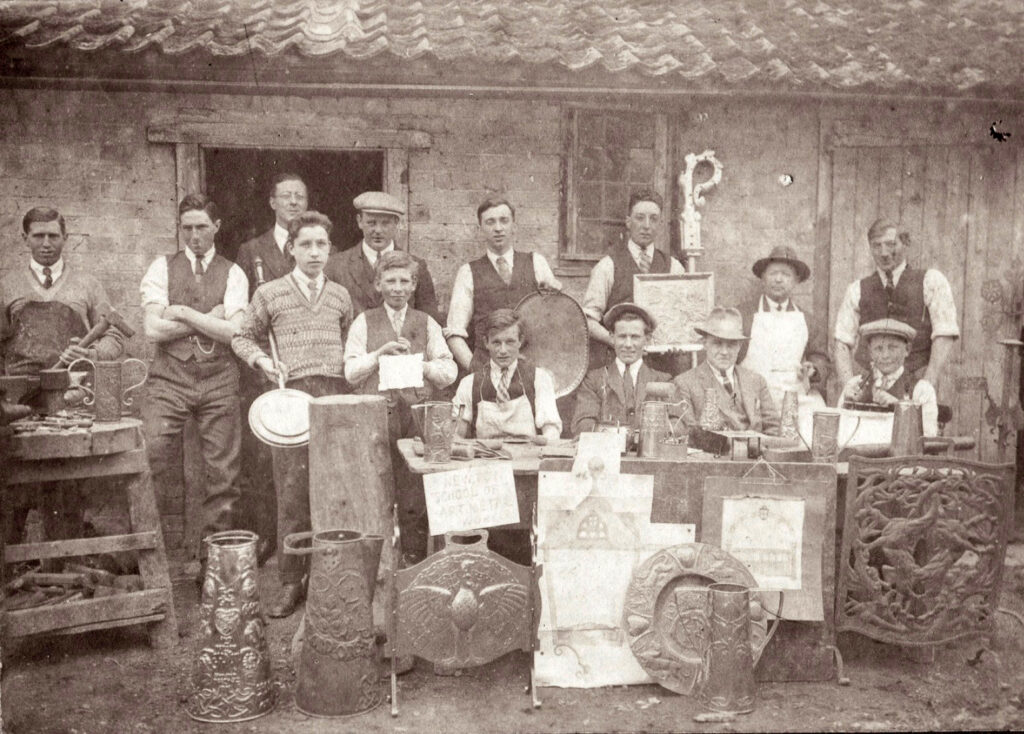
Fig. 32 – Workers at the School, c.1925. Back row, right to left: Percy Millen Albert Prime, George Mead, Gordon Pluck, Bert Fuller, Fred Lyon, Ted Barford, George Rogers. Front row right to left: Unknown, Laurence Fuller, Jimmy Fuller, Charles Tyrrel, Edward Fuller, Unknown. (Private Collection).
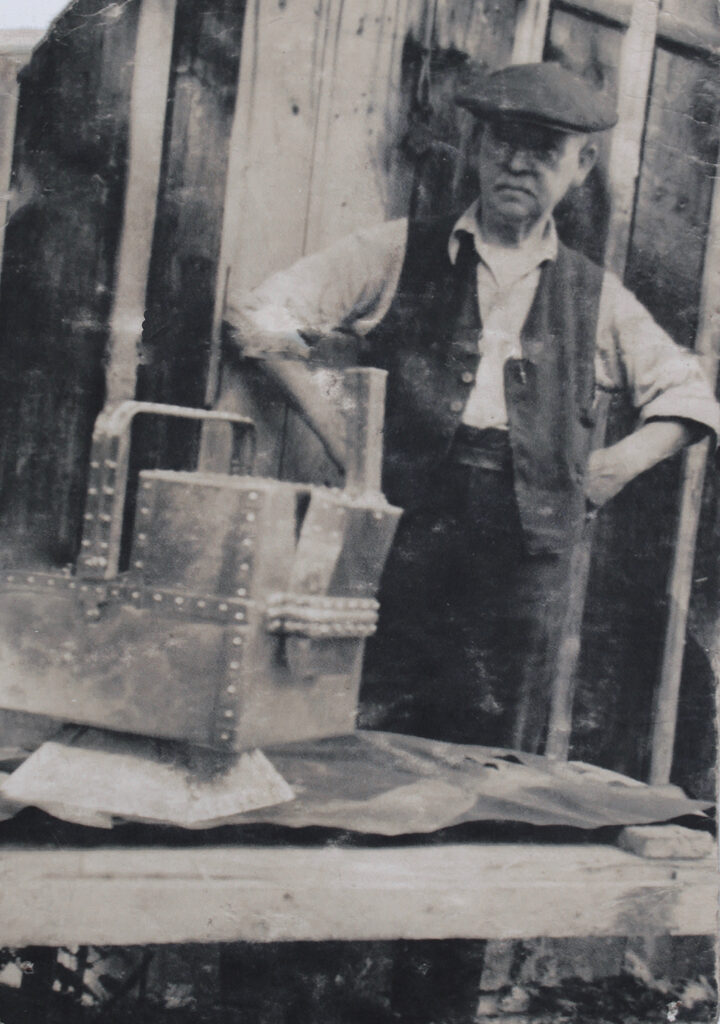
Countrywide displays of work also continued, as evidenced by an exhibition of handicrafts held in Corbridge, Northumberland in 1928. [57]
The School continued to operate throughout the 1930s; an attendance register from 1933 shows 12 people still attended the classes. Activities at the workshop gradually dwindled, ending completely mid-way through the Second World War.
Right until the end the metal work produced remained predominantly in the Arts & Crafts style. Albert Prime produced a small number of new designs but these were simpler, in keeping with modern tastes. The School also received commissions from individuals and companies aware of their skills and capabilities. Albert continued to work during the War and the American airmen based at nearby airfields were keen to buy anything he made. Even after the war Albert continued to use the workshop on an ad hoc basis to complete commissions. (Fig. 33)
LEGACY OF THE NEWTON SCHOOL OF METALWORK
Many of Newton’s current residents are aware of the School’s existence and there are a few visible reminders, such as the street-lamp erected in memory of Harold Hurrell, in the centre of Newton. The lamp, made by Albert I Prime, was erected in 1927 as a permanent reminder of Hurrell’s contribution both to the School and the village. (Fig. 34)
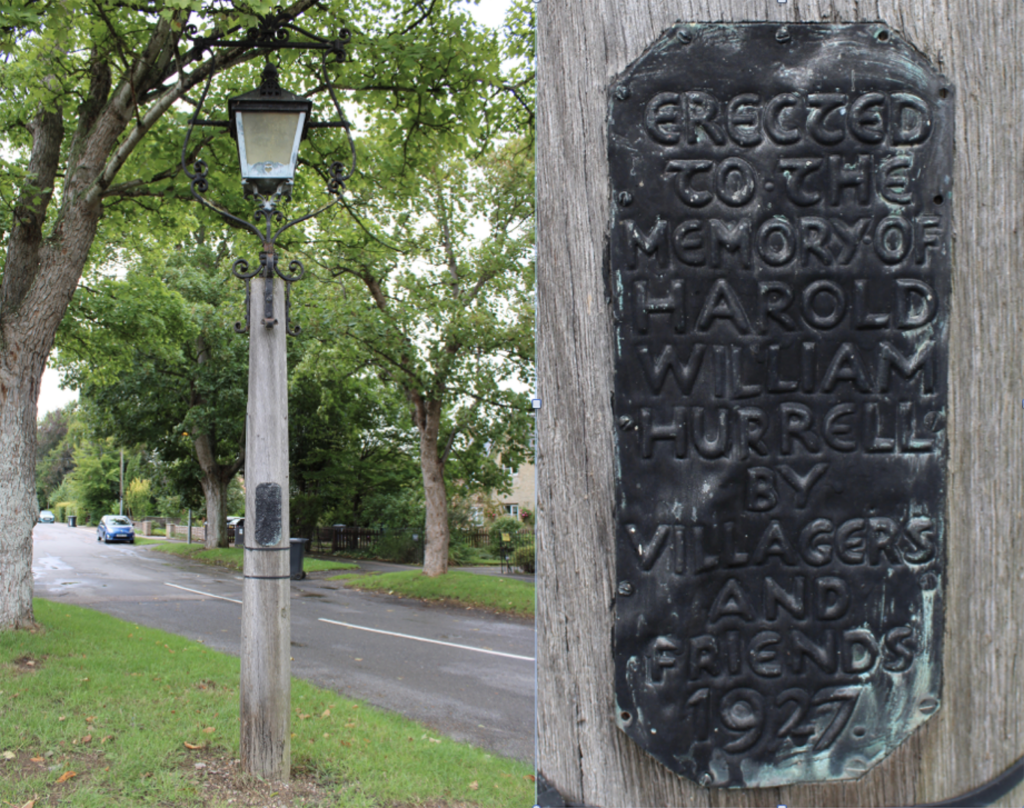
Among the commissioned pieces unaccounted for are a prize-winning sign made for the Green Man Tavern at Grantchester in 1900. [58] Happily, others, thought to be lost, have recently resurfaced. Around 1900 Albert Prime made the largest panel ever produced by the School for the front of the Drill Hall on East Road, Cambridge. The 4 ft-square copper panel comprised the coat-of-arms of the United Kingdom. lt was thought to be lost when the building was demolished many years ago, but thankfully it has been traced to an Army Reserve Centre on the outskirts of Cambridge. (Fig. 35)
The School was one of the longest running metal work classes inspired by the Arts & Crafts Movement and would have produced thousands of pieces of art metal work. The appearance of known designs at auctions over the last few years suggests that Newton School work regularly comes up for sale. The School had no maker’s mark although some pieces have inscribed initials or names. Usually the work is not recognised, often simply attributed to John Williams or incorrectly attributed to the Fivemiletown Class. Much of the work was sold in the Cambridge area and many families still have pieces handed down from workers at the School. The School also sold work throughout the UK and abroad, known commissions went as far afield as India.
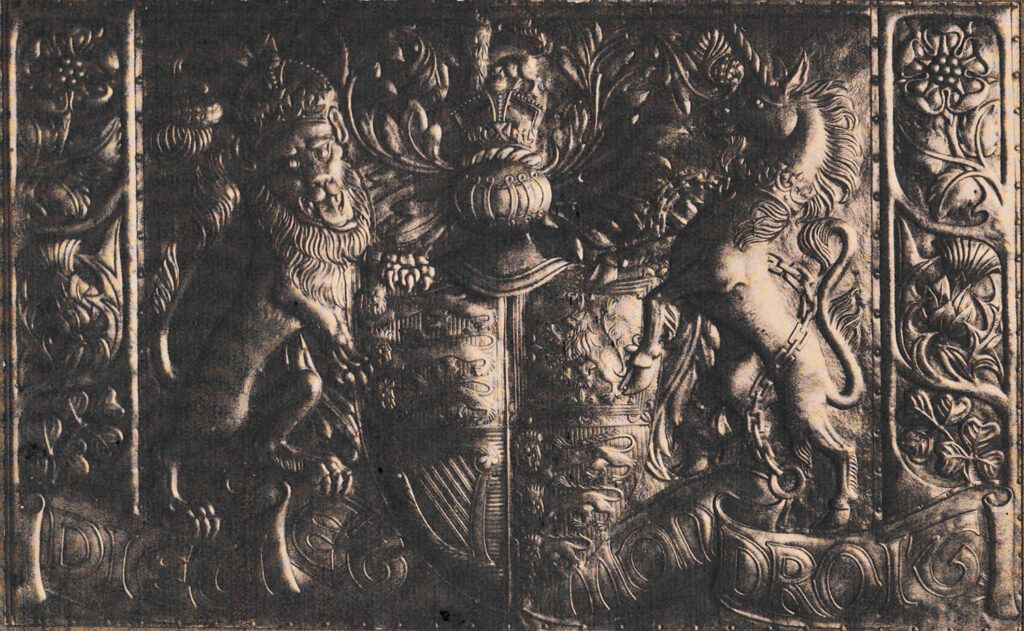
The School stayed true to the ethos of the Arts & Crafts movement, with the designers and craftsmen working in dose collaboration to produce beautiful and useful objects that are still appreciated today. Equally, if not more successful, than many other better-known metal working classes that emerged from the H.A.I.A, their history was largely ignored when the Arts & Crafts Movement regained popularity in the late twentieth century. However, thanks to the foresight and generosity of a local resident with a passion for the history of their village, the School’s story can finally be told.
ACKNOWLEDGMENTS
First and foremost, I would like to thank Bob Pluck for so generously sharing the wealth of information, designs and photographs he had the foresight to retain many years ago. Additional thanks for sharing his memories of the School and the key characters involved. Thanks also to the following: David Short for his help during visits to Newton, Tony Peart for his advice and additional information, Wallace Campbell and Paul Reeves for allowing me to use images of items from their collections and Alison Pattison (Curator of Godalming Museum) for kindly sharing information.
NOTES
1 Jessie Hall, About Newton People, unpublished booklet written in 1988 last reissued in 2003 pp. 1-2, 34. The 1881 census returns showed 54 occupied houses and 226 people living in the village.
2 Jessie Hall, About Newton — Town Street, unpublished booklet written in 1988, last reissued in 2003 pp. 25-26.
3 Ibid. p. 12.
4 London Evening Standard, 7 June,1889, p. 3.
5 As note 3.
6 Alan Crawford, C. R. Ashbee: Architect, Designer, and Romantic Socialist, (New Haven, Connecticut, London, Yale University Press, 1985), pp. 32-46.
7 As note 3.
8 Cambridge Daily News, Sunday, 26 September,1926, p. 5.
9 As note 3.
10 Miss Nash is referred to in several newspaper articles between 1891 and 1900: Herts. and Cambs. Reporter, Friday, 18 Dec, 1891, p. 5. Cambridge Independent Press, 2 June, 1893, pp. 7-8, and 8 Apr,1898, p. 6.
11 1891 England census for Ann Eliza Nash, Newton, Cambridgeshire.
12 England & Wales, National Probate Calendar (Index of Wills and Administrations), 1858-1995 (1902) for Eliza Hester Nash, Newton, Cambridgeshire.
13 England & Wales, National Probate Calendar (Index of Wills and Administrations), 1858-1995 (1906) for Ann Eliza Nash, Newton, Cambridgeshire.
14 Annual sales rose gradually from £80 in 1899 to £300 by 1907.
15 Albert Aaron Prime – England & Wales, Civil Registration Birth Index, 1837-1915.
16 1891 England census for Albert Aaron Prime, Newton, Cambridgeshire.
17 Herts. and Cambs. Reporter, 8 May, 1896, p.4.
18 1901 and 1911 England census for Albert Aaron Prime, Newton, Cambridgeshire.
19 1881 England census for John Williams, St Luke’s, London.
20 As note 6.
21 Paul Larmour, The Arts and Crafts Movement in Ireland, (Belfast, Friars Bush Press, 1992), p. 39.
22 Ibid. p. 39.
23. Cambridge Independent Press, 20 November,1908, p. 5.
24 1901 and 1911 England census for Mary Rachel Williams, Islington, London. 25. Paul Larmour (as note 21) p. 41.
26 Tyrone Constitution, 18 September 1896, p. 3.
27 The Studio, Vol. 17 (1899), p.105.
28 The Studio, Vol. 11 (1897), p.111.
29. 1881 England census for George Stephen Tanner, South Lambeth, London.
30 West Surrey Times and Guildford Gazette, 16 February,1884, p. 4.
31 1891, 1901 and 1911 England census for George Stephen Tanner, Godalming, Surrey.
32 West Sussex Gazette and South of England Advertiser, 4 October,1956, p.3.
33 The Studio, Vol. 7 (1896), p.58. Sixpence is listed as G.S. Tanner, The Knoll, Frith Hill, Godalming.
34 The Studio, Vol. 8 (1896), p.254.
35 Gillian Naylor, The Arts and Crafts 1VIovernent, London: Studio Vista, 1971.
36 The Studio, Vol. 3 (1895), p.150.
37 As note 6.
38 As note 6.
39 As note 23, 24 May, 1895 p. 6.
40 As note 17, 10 May, 1895, p.5.
41 As note 2, p.15.
42 Last Anglia Daily Times, 16 February,1910, p. 5,6.
43 As note 17, 18 December,1891, p. 5.
44 As note 36.
45 As note 39.
46 The Studio, Vol. 8 (1896), p. 96.
47 The House: A Journal of Home Arts and Crafts, Vol. 3, No 17 (July 1898), p. 165 and The House, Vo1.5, No 29 (July 1899), p. 162.
48 The House, Vol. 7, No 41 (July 1900), p. 167
49 As note 8, 7 Apri1,1900, p. 3.
50 The Artist: An Illustrated Monthly Record of Arts, Crafts and Industries, Vol. 31, No. 259 (August 1901), p. 136.
51 Arts & Crafts: A Monthly Practical Magazine for the Studio the Workshop & the Home, Vol. 3, No 14 (July 1905), p. 92.
52 As note 23, 16 November,1906, p. 4.
53 As note 23, 12 July, 1907, p. 3.
54. As note 23, 20 November,1908, p. 5.
55 As note 23, 8 May, 1914, p. 3.
56. As note 8, 25 September,1920, p. 4.
57 Newcastle Journal, 26 November,1928, p. 7.
58 Cambridge Chronicle and Journal, 13 April,1900, p. 4.